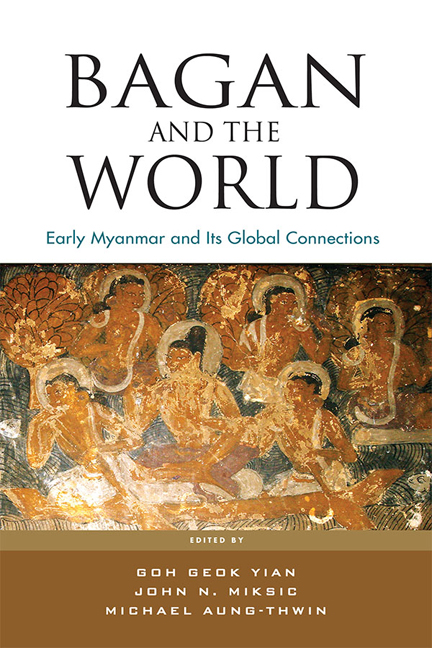Book contents
- Frontmatter
- Contents
- Preface
- Contributors
- 1 Keynote: The Myth of “Splendid Isolation”
- 2 Analysis of Construction Technologies in Pyu Cities and Bagan
- 3 Khraung-kaik Pitaka-taik: 16th-Century Repositories for Buddhist Scriptures in Mrauk-U
- 4 Religious Symbols as Decorations on the Sikhara of Ancient Monuments in the Late Bagan Period
- 5 The Viṣṇu on Garuḍa from the Nat Hlaung Kyaung Temple, Bagan
- 6 A Thousand Years before Bagan: Radiocarbon Dates and Myanmar's Ancient Pyu Cities
- 7 Ta Mok Shwe-Gu-Gyi Temple Kyaukse and Bagan
- 8 Silver Links! Bagan–Bengal and Shadowy Metal Corridors: 9th to 13th Centuries
- 9 Positioning Bagan in the Buddhist Ecumene: Myanmar's Trans-Polity Connections
- 10 Orthogeneity, Settlement Patterns and Earthenware Pottery Distribution in Bagan
- Index
- Miscellaneous Endmatter
4 - Religious Symbols as Decorations on the Sikhara of Ancient Monuments in the Late Bagan Period
Published online by Cambridge University Press: 01 February 2018
- Frontmatter
- Contents
- Preface
- Contributors
- 1 Keynote: The Myth of “Splendid Isolation”
- 2 Analysis of Construction Technologies in Pyu Cities and Bagan
- 3 Khraung-kaik Pitaka-taik: 16th-Century Repositories for Buddhist Scriptures in Mrauk-U
- 4 Religious Symbols as Decorations on the Sikhara of Ancient Monuments in the Late Bagan Period
- 5 The Viṣṇu on Garuḍa from the Nat Hlaung Kyaung Temple, Bagan
- 6 A Thousand Years before Bagan: Radiocarbon Dates and Myanmar's Ancient Pyu Cities
- 7 Ta Mok Shwe-Gu-Gyi Temple Kyaukse and Bagan
- 8 Silver Links! Bagan–Bengal and Shadowy Metal Corridors: 9th to 13th Centuries
- 9 Positioning Bagan in the Buddhist Ecumene: Myanmar's Trans-Polity Connections
- 10 Orthogeneity, Settlement Patterns and Earthenware Pottery Distribution in Bagan
- Index
- Miscellaneous Endmatter
Summary
Bagan iconography displayed syncretic traits from the 10th to the 13th centuries. Southeast Asian classic art combined traits from India, China and indigenous sources, disseminated through maritime trade. The Bagan period can be divided into three phases: early (10–11th centuries), middle (12th century) and late (13th century). The late phase of the Bagan period can plausibly be dated from the end of the reign of King Narapatisithu or Cañsū II (1165–1211) to that of King Narasihapate or Tayokpyay Min (1256–87). The successors of King Narapatisithu were patrons of Buddhist cultural heritage, evident in many monuments of various sizes, big, medium and small.
Despite the short span of the late Bagan period, many monuments were constructed during this time. They can be dated by stone inscriptions and ink glosses concerning donations and Buddhist religious matters.
The significant features of the later Bagan monuments include:
The construction of pagoda complexes consisting of several structures;
The evolution of monastic complexes in the vertical dimension;
More complex stucco reliefs on the temple exteriors;
An increasing frequency of geometric items in the interior mural decorations;
Stone inscriptions providing factual information about donations (mostly written in Myanmar language);
Monumental complexes built at greater distances from the banks of the Ayeyarwady River;
An increasing tendency to build complexes consisting of a large number of smaller individual monuments rather than single massive structures.
In the late Bagan period, many small monuments were built in the form of complexes of stupas or monasteries. Important groups of small buildings built during this period include complexes at Winīdo, Sambūla, Sin Phyū Shin, Su ton Pyit monastery and Tāmani. Despite the large number of small buildings, some larger buildings, such as temples at Tayokpyay, Pyatthatgyī, Tha Htay Mote Gu and Thitsāwaddy, were also erected. Additionally, there are medium size buildings such as the temples of Thambūla, Phayāthons and Thetkyamuni. The large number of 13th-century buildings in Bagan suggests that the population grew more rapidly in late Bagan than in earlier periods.
The 13th-century buildings are characterized by informative stone inscriptions, ink glosses and rich decoration, but these decorative touches were not intended as static and massive sculptural forms and shapes; rather, they comprise many items or thematic objects related to the use of Buddhist Jataka and canonical motifs to decorate interior walls for didactic functions.
- Type
- Chapter
- Information
- Bagan and the WorldEarly Myanmar and Its Global Connections, pp. 57 - 65Publisher: ISEAS–Yusof Ishak InstitutePrint publication year: 2017



